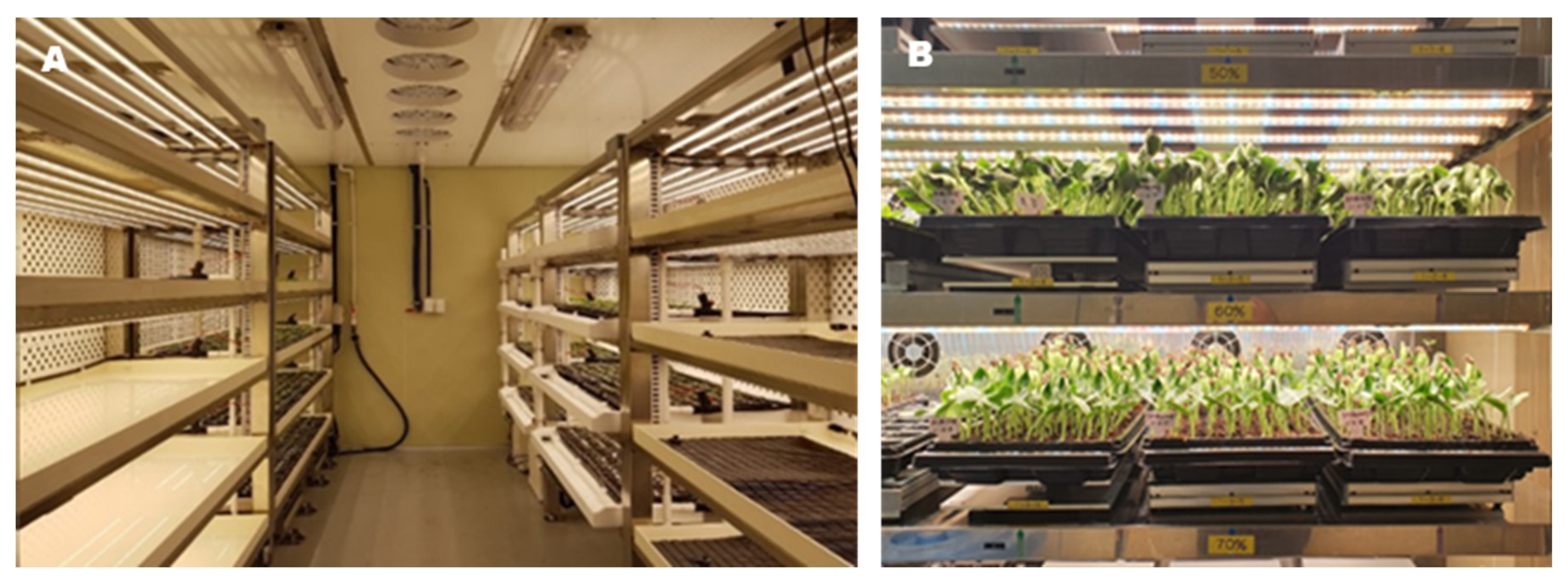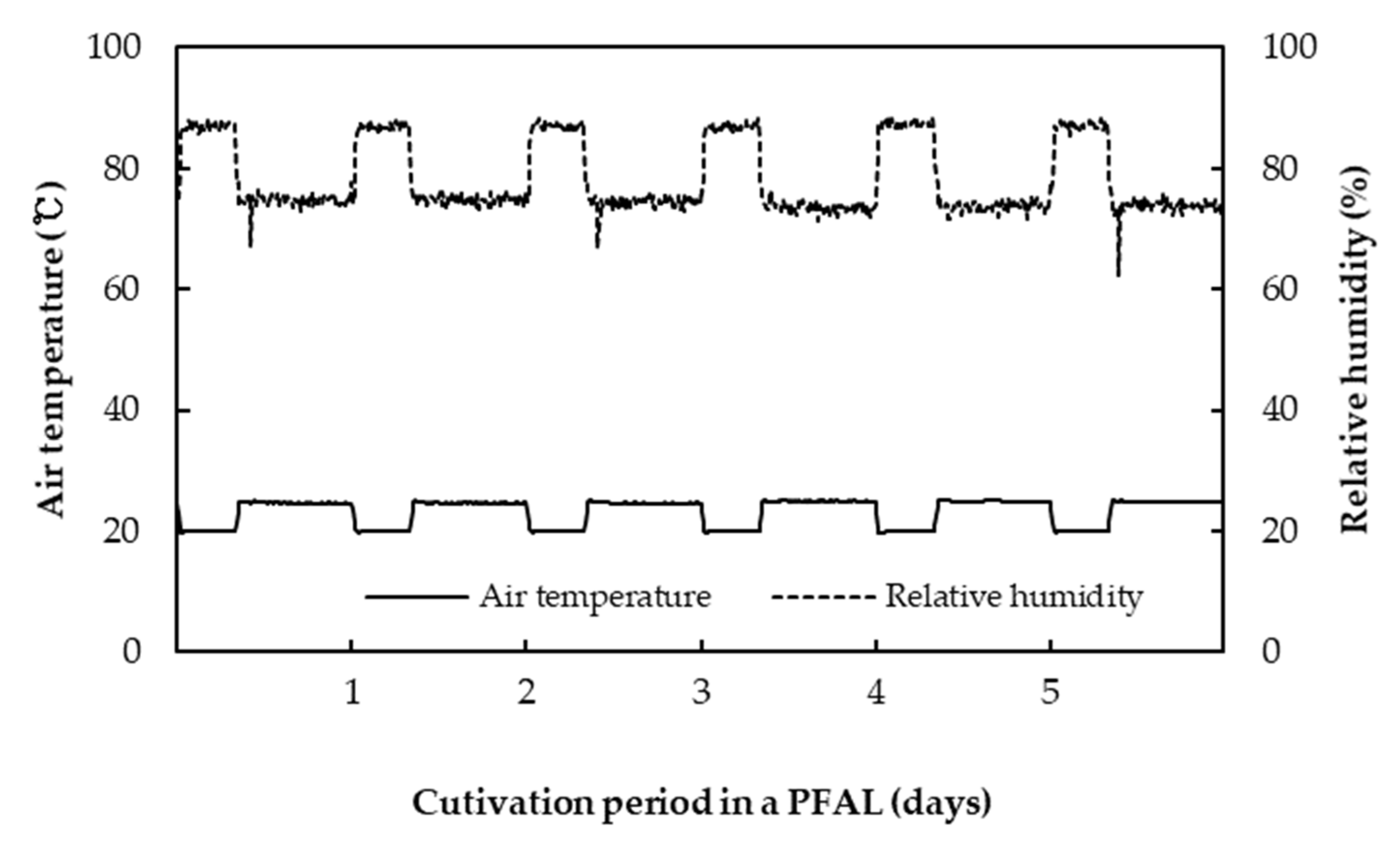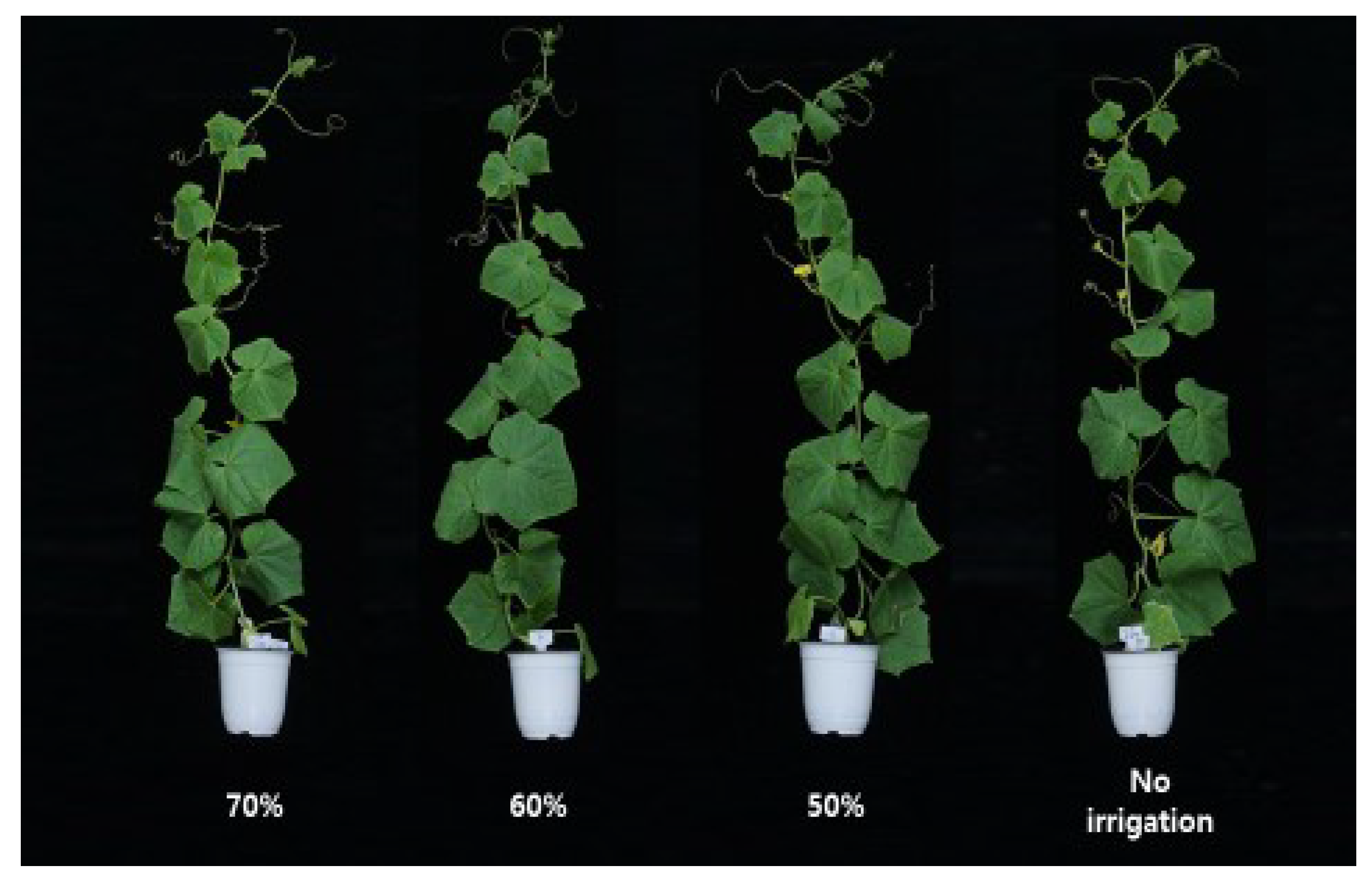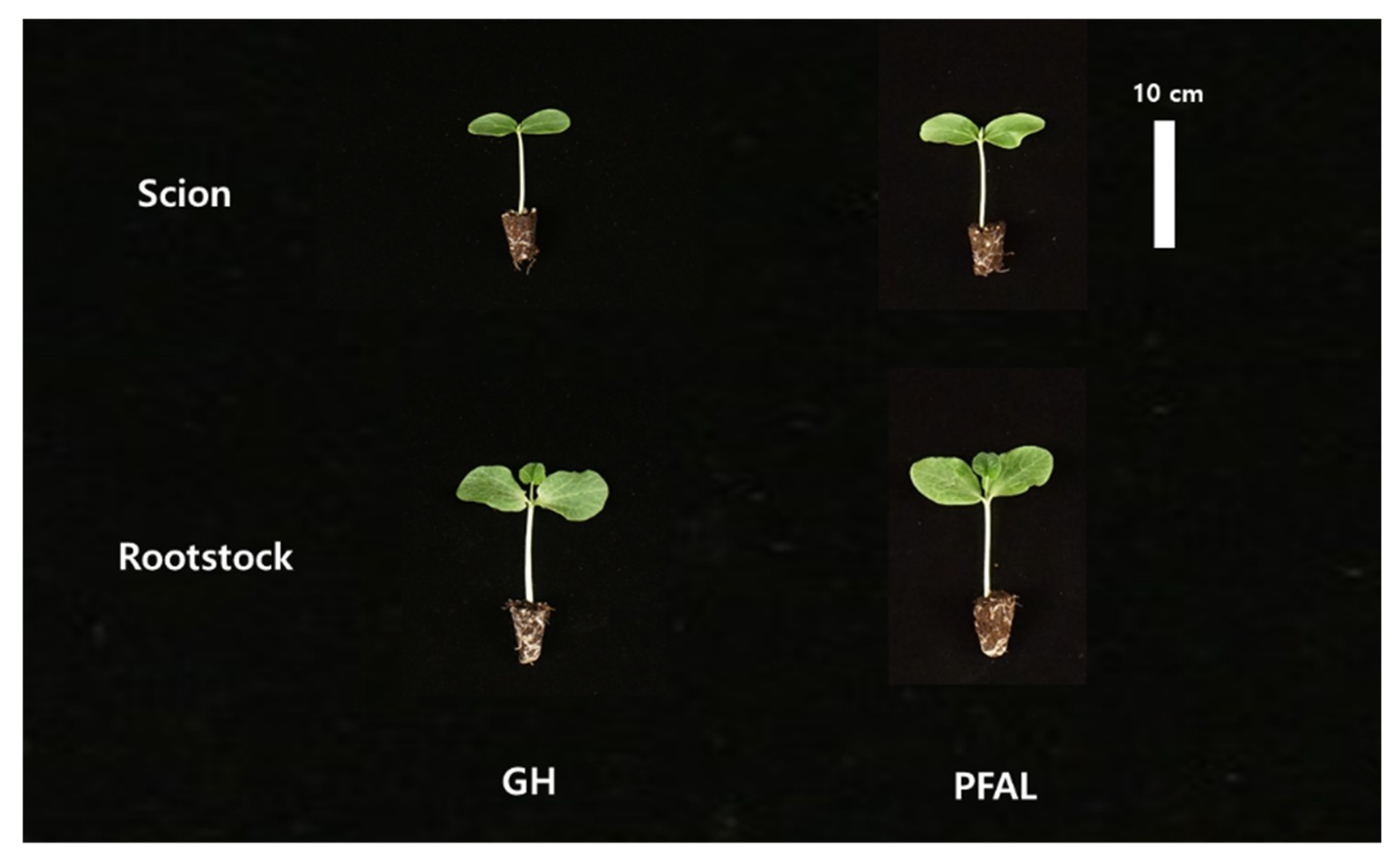1. Introduction
The production of grafted seedlings has been increased continuously to overcome several problems caused by successive and intensive cultivation in vegetables such as heavy infection of soil-borne diseases, stressful environmental conditions for plants, and the lack of well-balanced fertilizer [
1,
2]. The use of grafted seedlings can alleviate the problems associated with successive cropping and stress tolerance by using proper rootstocks.
Despite the advantages of grafted seedlings, the production of grafted seedlings compared with non-grafted seedlings has more complicated production processes and considerations that require a very high level of specialization [
3]. In particular, the uniformity of scions and rootstocks is a primary factor not only for producing good quality grafted seedlings, but also for increasing the efficiency of grafting. Furthermore, the grafting success and speed by grafting workers and machines can be promoted by the use of uniform scions and rootstocks [
4]. However, the production of uniform scions and rootstocks by the conventional method in a greenhouse is becoming more difficult due to extreme weather and climate change.
The plant factory with artificial lighting (PFAL) can solve the difficulties in the production of uniform scions and rootstocks. The PFAL is covered with thermally well-insulated walls and artificial lights such as Light emitting diodes (LEDs) are used as the light source for growing plants [
5]. The PFAL enables the production of a large quantity of high-quality seedlings because the environment in this system can be easily controlled and maintained without the issue of outside weather [
6]. Many researchers have reported that using the PFAL increased not only the quality and efficiency of seedling production, but also the performance after transplanting in horticultural crops [
7,
8,
9]. Although most research on the production of seedlings in a PFAL have focused on the control of the environment in aerial parts like light, temperature, and CO
2 concentration, there have been a few studies on the control of the environment in subterranean parts such as medium, nutrients, and water [
10,
11,
12,
13,
14].
In particular, the efficient use of water by irrigation is becoming increasingly important, and irrigation scheduling is considered as one of the key factors to save water in open field and protected agriculture including plant factories [
15,
16]. In almost all PFALs, a sub-irrigation system is applied and the irrigation scheduling is often controlled by a timer by setting an irrigation interval. Irrigation scheduling and water application programming are very effective tools for efficient water use in a PFAL, and soil or plant sensors are usually used for this purpose. However, it is difficult to use soil sensors in a cell of a plug tray as the volume of medium in a cell is too small and an increased root volume disturbs measuring the accurate water content in a medium. As the number and area of leaves in young seedlings are too small and many seedlings are cultivated densely in a plug tray, plant sensors also have limits to accurately measure the water amount required for the plants. Tateishi and Murase [
17] developed a micro precise irrigation device that could precisely control the irrigation in each cell of a 72-cell plug tray and confirmed the irrigation schedule by estimation of the evapotranspiration rate. However, there have been few studies that provide guidelines for irrigation to be applicable to the seedling production in a PFAL.
Therefore, this study aimed to figure out the optimal irrigation schemes for cucumber scions and rootstock production in a PFAL and hypothesized that the growth of cucumber scions, rootstocks, and grafted seedlings could be promoted by setting more favorable environmental conditions including irrigation in a PFAL rather than in a greenhouse. In this study, we set four different start points of irrigation by measuring the weight of the plug tray and investigated the growth of cucumber scions and rootstocks under different irrigation treatments in a PFAL. Furthermore, the growth of cucumber grafted seedlings after transplanting was confirmed when using the scions and rootstocks cultivated in a PFAL and GH.
4. Discussion
Water status during cultivation usually affects the morphology, physiology, and dry matter partitioning of seedlings [
21,
22]. Irrigation management can control the growth of seedlings, and is especially critical to produce high quality seedlings with proper morphological characteristics and the ability to survive or grow better after grafting or transplanting under different environmental conditions [
22,
23,
24,
25,
26].
Hypocotyl length, stem diameter, leaf area, and dry matter are the important factors in seedling quality [
11,
27,
28]. The hypocotyl morphology of the cucumber scion affected the survival rate and growth after grafting [
29]. Growth analysis including compactness, LAI, and LAR are used to understand the inherent differences in the response in plants under environmental stress conditions and can be used as important parameters to determine seedling quality [
11,
27,
28]. A seedling with high plant compactness (i.e., high dry weight and short plant height) is considered as a high quality seedling [
30,
31]. LAI and LAR reflect the size of the photosynthetic apparatus to receive light irradiation [
32]. LAR is one of the important factors that determine the growth rate of seedlings [
27], and fixing carbon per unit plant weight was reduced by low LAR [
33].
In the irrigation study in a PFAL (Exp. 1), the evapotranspiration rates of both ‘Joenbaekdadagi’ scions and ‘Heukjong’ rootstocks were increased by increasing the water content in the medium at the starting point of irrigation. However, the WUE was reduced by increasing the moisture content in the medium at the irrigation start point except that of cucumber scions in the 40% (no irrigation) treatment. The cucumber scions in the 40% irrigation treatment showed the lowest value of WUE because they were already under drought stress conditions and it suppressed photosynthetic carbon assimilation in seedlings. Therefore, the threshold of the irrigation start point for the production of cucumber scions in a PFAL should be set above 40% of water content in a medium.
As a result of the first experiment, 60% of water content in a medium was determined an efficient irrigation regimen and scheduling to produce ‘Joenbaekdadagi’ scions and ‘Heukjong’ rootstocks in a PFAL. The irrigation management was important for plant growth, but also needs to be considered on the side of saving water resources. The growth of cucumber scions and rootstocks was highest in the 70% irrigation treatment, however, the irrigation was conducted twice during the cultivation period in a PFAL. The growth of cucumber scions between 60 and 70% irrigation treatment was not significantly different, and the hypocotyl length of rootstocks in 70% irrigation treatment was too long compared with the proper size (the hypocotyl length 5–7 cm, [
34]) for grafting. Considering the growth of seedlings and irrigation efficiency, the proper start point of sub-irrigation was 60% of water content in a medium for the production of cucumber scions and rootstocks in a PFAL and the irrigation can be conducted once during the cultivation period.
The comparable study in the second experiment found that ‘Joenbaekdadagi’ scions and ‘Heukjong’ rootstocks production in a PFAL would be an effective tool to produce a stable and uniform quality of seedling constantly against various adverse weather conditions. In the summer season in Korea, the air temperature and light intensity during day time were very high in a GH and the growth rate of seedlings was fast. Therefore, the period of conventional cultivation in a GH (6 DAS) was shorter than that in a PFAL (8 DAS). In the conventional cultivation in a GH, the cultivation period and growth rate of seedlings were largely affected by weather and season. However, in a PFAL, the growth of seedlings was uniform because the cultivation environment can be maintained constantly regardless of outside weather and season.
Additionally, the results in the second experiment confirmed that seedling quality of ‘Joenbaekdadagi’ scions and ‘Heukjong’ rootstocks cultivated in a PFAL was greater than the conventional seedling production in a GH in terms of dry weight, stem diameter, and flower development. Although this study showed that the cultivation period in a GH was shorter than that in a PFAL, the hypocotyl length of seedlings in a GH was longer compared to the low dry weight of shoot and the compactness was lower than that in a PFAL. Ohyama et al. [
35] reported that the plant height of tomato transplants cultivated in a PFAL was lower and the dry weight was higher than that in a GH. The growth of cucumber scions and rootstocks cultivated in a GH was negatively affected by high air temperature and low irradiation conditions during the summer rainy season. The control of favorable environment conditions for plant growth in a PFAL increased photosynthetic carbon assimilation and reduced excessive stem elongation of seedlings, therefore, more compact and healthy seedlings in a PFAL were produced compared with a conventional cultivation in a GH.
According to Oda et al. [
29], the difference of stem diameter between cucumber scions and rootstocks affected the survival rate and growth of grafted seedlings. The reduction of the difference in stem diameter between cucumber scions and rootstocks was effective in promoting the survival rate and growth of grafted seedlings. The difference in stem diameter between scions and rootstocks in a PFAL (0.53 mm) was smaller than that in a GH (0.9 mm). The cultivation of scions and rootstocks in a PFAL could reduce the difference in stem diameter between scions and rootstocks, and it can be advantageous not only to promote the growth of grafted seedlings, but also to increase the efficiency of grafting by workers or machines.
Kwack et al. [
9] reported that the number of female flowers increased when the scions and rootstocks cultivated in a PFAL were used for the production of grafted cucumber seedlings. In the tomato seedlings cultivated in a PFAL, the node of first flowering was lower than that in a GH [
35]. The environmental control during the cultivation of scions and rootstocks can improve not only the growth of scions and rootstocks before grafting, but also the flowering response of grafted seedlings after transplanting. The differentiation of initial flower primordia was determined at the first leaf stage, and the environmental control at the cotyledonary stage could affect the flowering habit in cucumber [
36]. In general, the development of female flowers in cucumber is promoted by low air temperature and short day length conditions [
37]. The air temperature in a PFAL was lower than that in a GH, and it could have a positive effect on female flower development in the cucumber seedlings. Although the day length in a PFAL (16 h) was approximately two hours longer than that in a GH, it did not affect the development of female flowers. Fujieda [
38] reported that the effect of day length on the development of cucumber female flowers was encouraged by increased the number of true leaves and leaf area of cucumber seedlings. As cucumber scions and rootstocks showed 0–1 true leaves before grafting in this study, the increased photoperiod in a PFAL would improve only the vegetative growth of seedlings without a negative effect on the development of female flowers. The effect of the cultivation of scions and rootstocks in a PFAL on the vegetative growth after the transplanting of grafted cucumber seedlings could be offset, however, the flowering response after transplanting could be promoted by the cultivation of scions and rootstocks under favorable environment conditions in a PFAL.














